Venturing Permanence:
ETH House of Science Bamiyan, Afghanistan. Courtyard.
Facts: Open Competition „Luftschloss - 150 years ETH Zurich” | 1st Prize | 2004 | Execution 2004 - 2008 | Costs excl. Sponsoring and Salaries CHF 850’000 | Usable Area: 650 m2 | -> Competition Project, see also: Plans&Text
Students' Centre in Kandahar.
Architecture: Ivica Brnic, Florian Graf, Wolfgang Rossbauer (Brnic, Graf, Rossbauer Architects, Zurich) | Building Physics Prof. Dr. Bruno Keller, Stephan Rutz (ETH Zurich) | Structural Engineer Prof. Dr. Joseph Schwartz | Construction ManagerAsef Alemyar, Herat and Rorschacherberg.
Client: ETH Zurich | Representation Client:Prof. Dr. Mario Fontana, D-BAUG (IBK) | Committee for further collaboration: Prof. Dr. Olaf Kübler, President emeritus ETH Zurich | President Committee Jubilee: Prof. Dr. Meinrad Eberle, Corporate Communications.
Competition for the ETH jubilee.
With
the 150th anniversary of the Swiss Federal Institute of Technology
Zürich in the year 2005, a competition was advertised for
the faculties of Architecture and Civil Engineering. The requirement
was to design any kind of building on the terrace in front of
the ETH’s main site, which would represent these two departments.
The building was planned to be a temporary installation during
the festive period in April/May 2005. Out of all submitted 49
projects, our proposal, code-named: „Polynational”
was nominated for execution.
The
unusual aspect of this competition is certainly the simultaneous
demands: The physical architectural project and the content, its
programmatic use, were to be formulated. Our project does not
transmit the meaning of architecture using a purely demonstrative
object, like a festive pavilion, which tries to abstract „real“
architectural demands like utility, construction, form and present
them as a model to the public. Our aim is to show architecture
„in action“, acting with all the fundamental human
needs. Incredibly,
half a million Swiss Francs (original budget) would barely cover
the costs for building and maintaining a pavilion on the ETH’s
Polyterrasse. The ETH’s main building, a hallmark of the
city of Zürich, is itself a „Luftschloss” (=„castle-in-the-air”).
Its vast functional space provides room for an array of possible
events. In a developing country, or one in the process of reconstruction,
the utilisation of this sum will be multiplied by a large factor.
Our suggestion was therefore to invest the money in a sustainable
way in a country in development, and through that to initiate
a world-wide exchange of knowledge and information with the ETH.
We
were planning the construction of a small building on a campus
of the Bamiyan University, Afghanistan. The building will function
as a platform (politically neutral and without religious affiliation)
which would facilitate the exchange of knowledge between Afghan
and Swiss students, and which would offer the possibility of social
meeting for the students. Common projects or seminars in Afghanistan
will be a plan to strive towards (a committee for the exchange
was already founded, including politicians of both countries,
professors of both universities and students) that is, to foster
a long-term relationship between the Afghan University and the
ETH. It has been so far planned that the students will develop
projects for the reconstruction of parts of the city, study new
technologies of building construction, hydraulic engineering to
improve the local water utilities, and research on agricultural
problems. ETH has the opportunity to explore the still „open“
field of architecture in Afghanistan first hand. At the same time,
the advantage for Afghan University would be to have a leading
consultant by its side.
Swiss
public was included in our plans: By rendering our project accessible
through both an installation and exhibition our concept was communicated.
The installation took place on the Polyterrasse of the ETH, in
which construction posts were set up to demarcate the volume to
be built in Afghanistan; a copy of the original pre-construction
site. A further exhibition in the lobby of the main ETH foyer
also was open to the public.
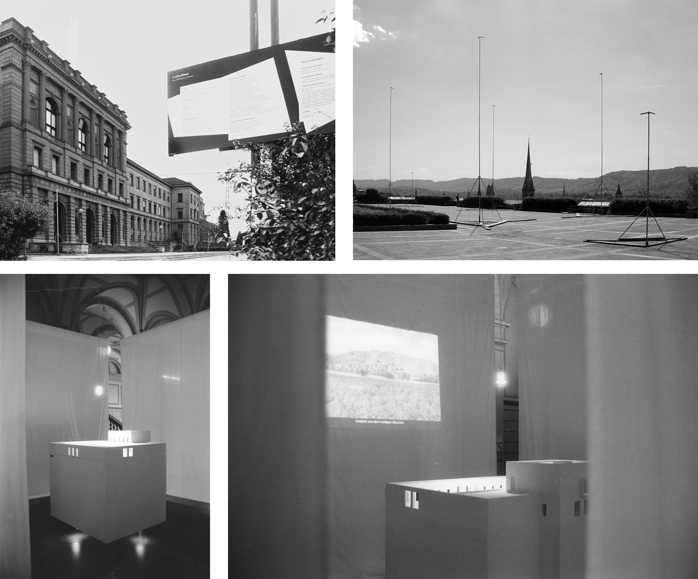
 Exhibition
at the ETH Zurich: Information Board, Construction Posts (on the
"Polyterrasse") and a Model (Vestibule). Exhibition
at the ETH Zurich: Information Board, Construction Posts (on the
"Polyterrasse") and a Model (Vestibule).
A Courtyard
in Bamiyan.
In
collaboration with Bamiyan’s recently reopened university,
the functional program was worked out: a large auditorium (120m2),
a library with internet facilities (80m2) and a laboratory space(80m2).
Smaller spaces are planned for security, technical facilities
and micro-apartments for guests. The plans supplement the University
of Bamiyan’s existing buildings. They have been drawn up
in such a way that the buildings will remain highly practical
even if their designated use is changed.
Bamiyan
is situated at a high-altitude and experiences low temperatures
and strong sunlight. An energy concept focused on heating has
been designed based on a simple spacial system. After having researched
the climate and cultural traditions in the region, we have come
up with a long, south-facing building fronted by an imposing reception
area, a courtyard. Behind the building a garden is planned, allowing
room for any future extensions.

 Situation
Winter (direct radiation) - Situation Summer (shadow niche) Situation
Winter (direct radiation) - Situation Summer (shadow niche)
A
resilient brick wall - a homogenous combination of shock-absorbing
cob bricks in the core of the wall and fired bricks on the outside
surface - and a temperature-regulating system of double-glazed
windows (2 meters distance) are designed to produce a comfortable
temperature inside the building. Apertures in the external facade
are fitted with highly insulated windows that nevertheless let
through maximum sunlight. These windows ensure that as much sun
as possible comes into the building during the winter. In summer
they are opened, though those in shade (internal windows) at the
bottom of the facade are kept closed to keep out the wind and
ensure that cooling energy is preserved within the building.
All
work was being carried out by local workers using technologies
and practices that are rooted in the local culture - Only few
technical equipments were imported: solar systems, windows, interior
equipment like computers.
The
inauguration was in fall 2006, the academic use started in spring
2007.
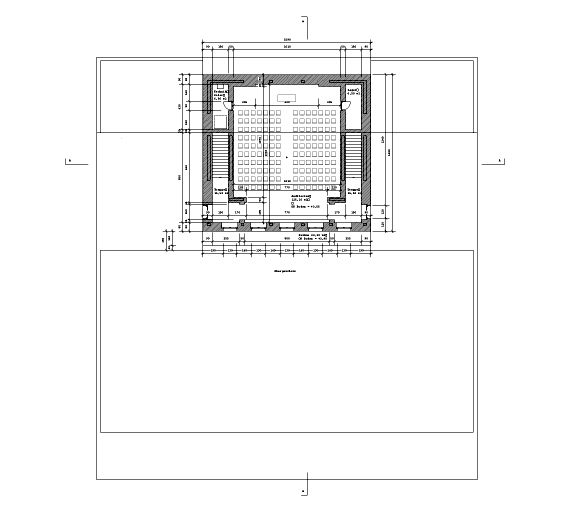
 First
Floor (Auditorium) First
Floor (Auditorium)
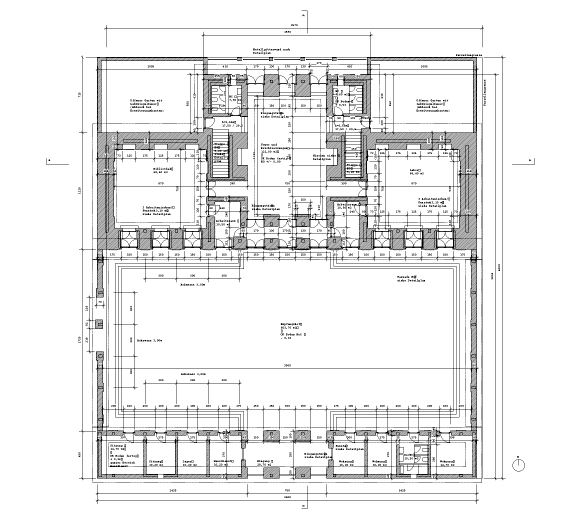
 Ground
Floor (Courtyard, Foyer, Classrooms, Toilets, Guest Rooms) Ground
Floor (Courtyard, Foyer, Classrooms, Toilets, Guest Rooms)
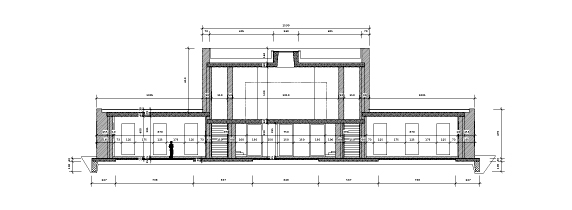
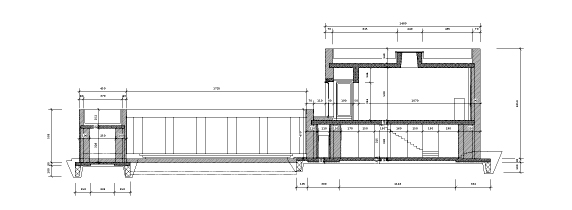
|